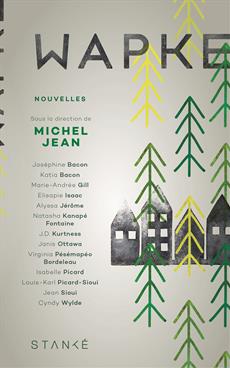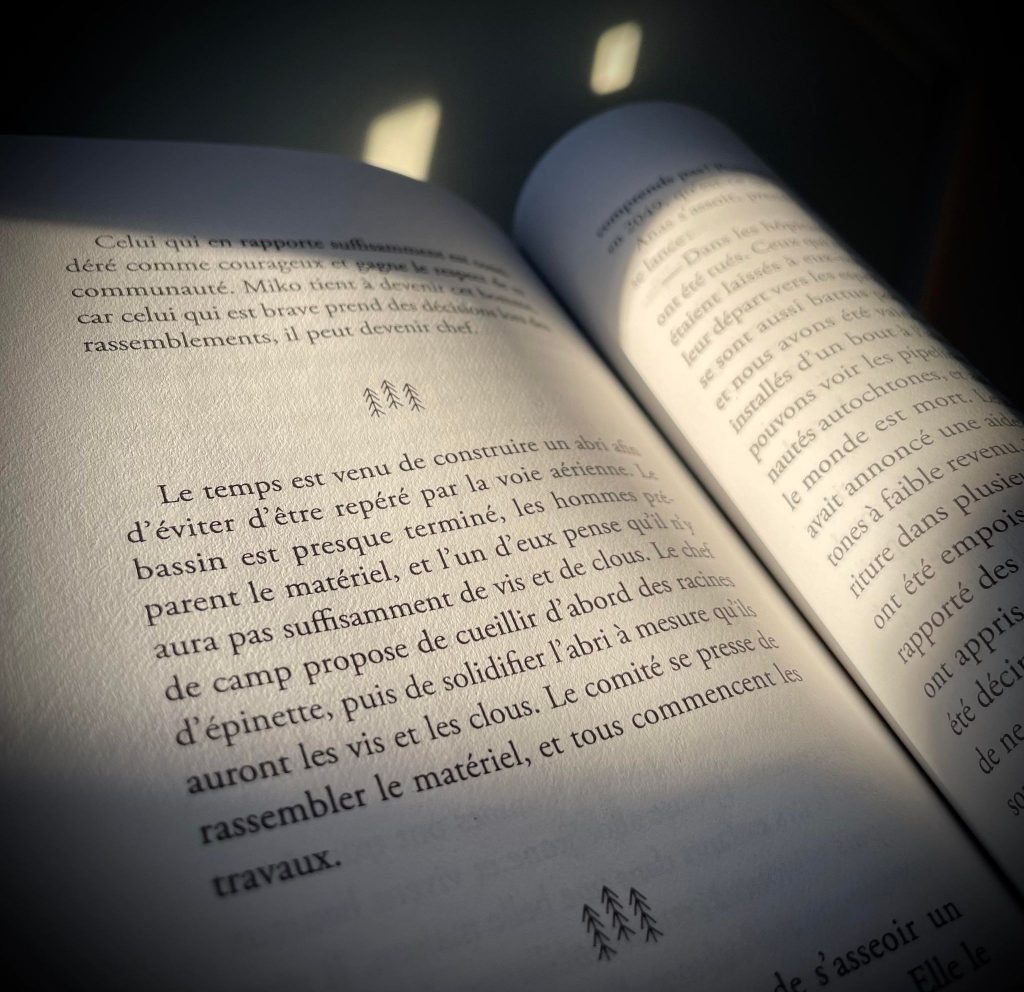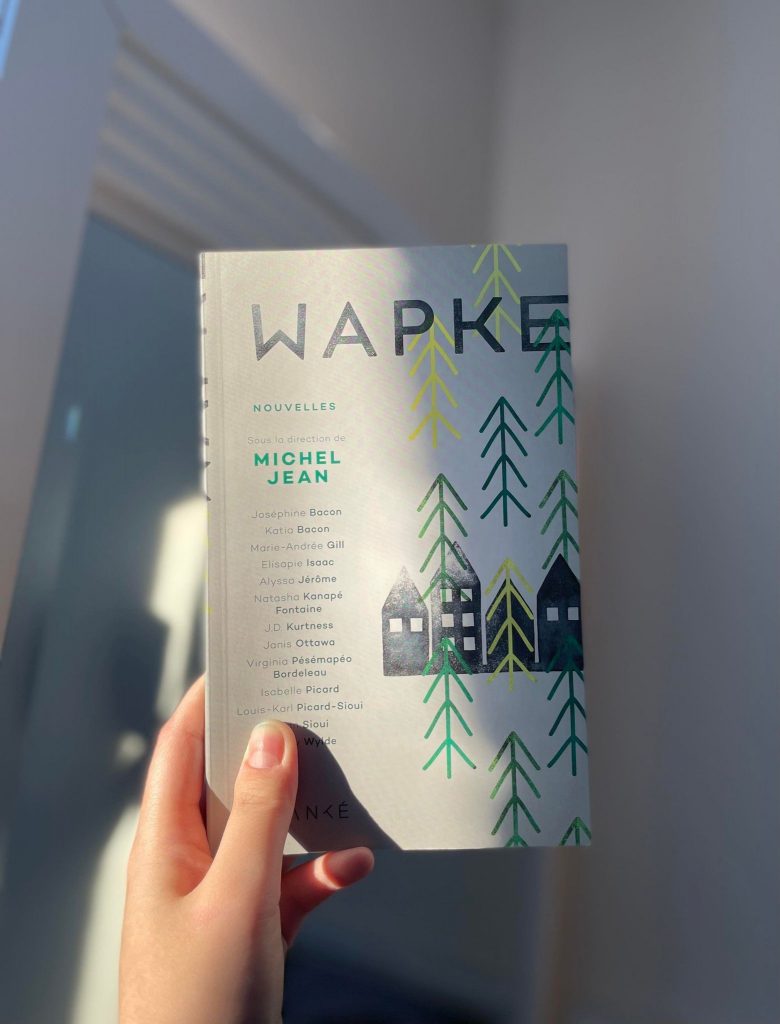Wapke, which means “tomorrow” in atikamekw, is a collection of short stories written in French by fourteen Indigenous writers under the direction of novelist Michel Jean. Each of the stories follows Indigenous characters as they live amid dystopian visions of the future— some are navigating daily life amid total societal collapse, others are simply trying to survive during an ever-changing, ruthless ecological (and political) climate.

All of these short stories are part of the relatively new genre of Indigenous futurism. The movement—which is not strictly limited to writing—provides a space for Indigenous writers and artists to explore ideas through speculative fiction. As its name indicates, Indigenous futurism places Indigenous writing, culture, and art in the future, whereas historically, many Indigenous stories only portray the past or the present. This represents a claim to Indigenous permanence in the face of our unstable 21st century.
During the latest iteration of the Salon du livre de Montréal, a live “table ronde” event animated by Michel Jean included several authors featured in Wapke. Having both attended the event and read the book, English section editor Olivia Shan and contributor Chloe Azoto sat down together to discuss the anthology.
(Warning: Spoilers ahead!)
Olivia: In many of the stories in Wapke, there seems to be a constant motif of individual characters positioning themselves in relation to their communities and their peoples’ histories. A great example–and one of the most moving stories in the book for me—is “Cécile”, in which we follow the life of a very elderly Indigenous woman. Cécile is an individual character of course, but I think that the text is really highlighting all the history—the stories—that Cécile herself represents.
Chloe: There’s a couple of interesting themes in this story because Cécile also has this incredible need to repeat the same structure of the day every single day. There must be some connection to the broader theme of the repression of history, and how an individual needs to cope with the kind of hardships she had to face across her long life. And then there’s also Cécile’s intense Christianity. She prays about three times a day. We could understand her intense routine like an extension of a coping mechanism for a lifetime of trauma.
O: There’s this contrast between her very sterile solitary life, which is described in the present narration, versus how the author talked about her house. When her past with her husband and children is described, it all seems very colorful and full of life.
C: Exactly. Then for the story “Le Quatrième Monde,” I wanted to talk about the character of Elsie, who is fighting with a resistance movement against a modern anti-cultural world. There is also a Russian shopkeeper trying to hide these cultural artifacts that connect the sterile current world to this creative cultural past. Again, there’s a very stark contrast between the past and the present. There’s also that little twist at the end, revealing that Elsie is actually harboring the shopkeeper’s son, and he is also a secret resistance fighter. So even though they’re not actually related, they are united through their desire to preserve these cultures. It’s this bigger sense of family combating against the crushing desires of the state.
O: I like how throughout the story, this act of preservation of culture is treated as a necessary thing, an essential thing. It’s not frivolous at all.
C: You can contrast that to the tyranny of the men who come into the shop, too. They are the ones responsible for repressing all cultures. They forcibly take Elsie’s shoes. It almost seems like they get a sense of pleasure out of bullying these women.
O: Another theme that I thought was interesting was that of nature with and/or versus technology. In “Uapush-Unaikan,” the main character’s community is promised that after a certain number of years of service they could go back to the wild, away from their oppressive high-tech society. At the end, you realize that their “retirement” is imposed on them in a very literal sense—these Indigenous people are being transformed into animals and released into the woods. I think this is the kind of story that really turns the idea of returning to nature on its head. Usually it’s a pretty universal, romantic ideal, right? However this story asks us whether it’s actually a good or feasible idea, or whether it’s completely disconnected from real life.
C: There’s also the question of how they got the technology to turn people into animals in the first place. There’s the underlying idea of potential abuse of technology against Indigenous people.
O: Yes, it’s a perverse, dehumanizing rendition of this whole concept.

C: The very first story,“Dix jours sur écorce de bouleau,” also features an interesting relationship between nature and technology because an entire group is stranded in the woods. The narrator is at an age where she can remember a past that is filled with technology— the kind that we’re used to. She talks about how she used to play video games with her friends and eat poutine. Now she’s living in the woods with a broken leg, writing on pieces of bark. It captures the in-between of the collapse of society and of a high tech far-future. In this unsure middle state, the main character herself doesn’t really know what to write about, which kind of translates to a certain uncertainty about the future.
O: I totally agree. This also makes me think about how well the short story collection is edited. The placement of all the stories is great. I feel like this was an excellent story to begin with; it’s a very immediate, and intimate story, because it’s made up of diary entries full of quotidian mundanities. However, all these connections and references to our daily lives are a nice contrast to the completely alien environment in their current life.
C: Right. It makes me think of the story “Les grands arbres”. It’s interesting because in this story there is barely any explicit mention about its futuristic element. You’re just thrown into this new world.
O: The impression I get is that we’re reading about a very distant future. The main characters live in a community of Indigenous people that have somehow found themselves in the wild and are thriving there. It almost seems as if centuries of history hadn’t happened and they’re back in pre-colonial times.
C: Yes, there’s a sense of timelessness in this story that I find very cool.
O: The way the story unfolds was really surprising to me. The main character of the story—who’s a huntress— goes on a quest, then meets a beastly, otherworldly creature that she can’t quite pin down or describe. However, there’s no epic showdowns or much conflict at all.
C: It’s weird because I’m not sure if she succeeds or fails on this quest even though her tribe insists on the importance of her journey and doing it right. We know that the tribe chooses someone to do it every year, but we don’t know why they do it or if the other people who also went on the quest had similar experiences as our main character…
O: In the story there’s also almost no presence of white people—I don’t think they’re mentioned at all, right? It seems like for this group of people, the wild is still wild. When the hunter meets this beast and her brother comes to save her, they’re just like “let’s go home!”. There seems to be no attempt to control or to impose themselves violently even in the face of this potential threat. It’s just something that they coexist with. It’s a form of accepting the other.
C: It’s interesting because in a lot of these stories it’s pretty explicit that it’s the settler or the white person who is the bad guy, but here it’s sort of pushing that concept away. It’s showing readers that Indigenous people have other problems to deal with. It’s not always about the relationship to white people or to settlers—sometimes they just have their own stuff going on. Sometimes there’s this overt notion that comes from the “noble savage” trope, which equates Indigenous people with nature, whereas here there’s a clear distinction between the terror and potential dangers of nature and where they return— home.
O: Another story which features nature very heavily is “2091,” which follows the story of Tayara, the Arctic tourist guide. There was one particular description that really stood out to me. The narrator here is describing one of the Arctic bays:

“Il est beau, pas un genre de beau que tu vois, mais plutôt un genre de beau que tu ressens. Sa présence s’impose. Il a toutes les caractéristiques de l’homme Inuk. Il est avenant, il a ce regard imprégné d’une tristesse douce, qui en même temps est fier et droit comme une flèche, et qui touche les cœurs à tout coup. On s’y sent en territoire connu, c’est un regard sans jugement.” (p. 109)
Here, the landscape is described as bearing the same physical, emotional traits as an Inuk man. I was stunned when I first read that passage, it’s really beautiful.
C: Right, the story seems to be mainly about one’s relationship with nature. It’s almost like this landscape has a hold over Tayara. It seems to supersedes any human relationships.
O: Even though there’s all these mundane concerns, the vastness of nature is still a humbling thing. In the story, Tayara is also a tourist guide, so he’s literally introducing people to this landscape.
C: Exactly, that’s his whole job, right? It’s connecting people to nature.
O: I think the story is actually pretty optimistic, which is a nice contrast to some of the other ones. There were also bits of socio-political commentary in many of the stories which was fascinating to read about.
C: Yes, like the story where white babies are born blue, “Les couleurs de la peau.”
O: That one was really interesting. While white babies are blue, Wendat babies are born with normal skin tones, and it becomes a huge point of scientific fascination. I feel like in discussions of racial discrimination we sometimes zone in too much on merely talking about skin color. But this story is exposing how, at the end of the day, race and race dynamics are based on structures of power. And that racism— and specifically anti-Indigenous racism here— is a wider symptom of this system.
C: Right, changing literal things like skin color is bullshit. The story is definitely reinforcing that fact by making these babies blue, a totally silly color. That is where the satiric element comes into play. In the end, it’s as if they took in all these Indigenous children for nothing, right?
O: Exactly. Symbolically it just becomes another vicious circle of Indigenous people in Canada suffering and people in power not taking accountability for their actions. Wapke feels like a timely work, but it’s also very diverse. There are so many different things going on. Though there are main overlapping elements that keep popping up, each story offers a unique perspective, giving their own spin on these common motifs and themes.
C: We can talk about the title a bit too. Wapke literally means “tomorrow” in atikamekw, but what kind of future is it pointing towards? Is it the distant future? Is it two days from now? It feels vaguely threatening, almost like a warning.
O: To tie back to what the authors discussed during the “table ronde”, while reading this book, I can’t help but think about the very question they were debating about; what is Indigenous literature? Like some of the authors expressed, I’m very much of the opinion that trying to categorize this is a bit pointless and ridiculous, but it’s really cool how this anthology tackles that question. You can see it for instance in the way the book presents each author.
C: Exactly, after every writer’s name, the book indicates their tribe affiliation, so you know who they are, where they come from. It’s showing that Indigenous literature is something that’s linguistically, regionally diverse. It’s not all just under the banner of “Indigenous fiction”. There are fourteen distinct voices here.
O: It’s exciting that this book seems to be getting some well-deserved attention. It might become one of the pioneering, seminal works of a whole movement, a whole sub-genre even. This is a really promising start.
Here is the link to watch the entire “table ronde” from the Salon du Live— featuring Isabelle Picard, J. D. Kurtness, Joséphine Bacon, and Michel Jean:

1 Comment